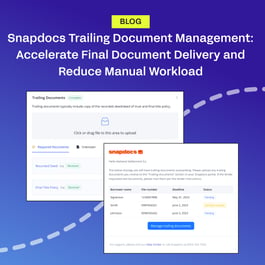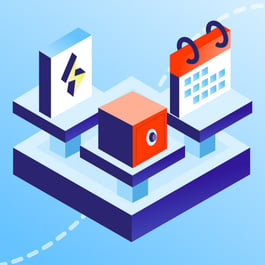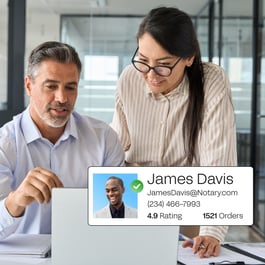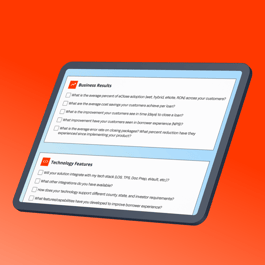What does being successful with digital closings look like? Many would say it’s being able to offer fully remote eClosings. That isn’t the real end goal though.
“Don’t get distracted by digital closings. It’s actually a means to an end. Ultimately, what you’re driving toward are business improvements around the accuracy of documents, the consumer experience, expedience, transparency, ease of funding, shortening time frames.”
—Aaron King, Founder and CEO of Snapdocs.
These improvements are the end result that lenders should be working toward and using digital closings to achieve. They’re the lens through which you should be vetting eClosing platforms and how you should be measuring your success.
To determine whether you’re truly getting value out of digital closings, here are six key metrics that you should track and results that other lenders have seen. Keep these metrics and benchmarks in mind as you evaluate vendors and implement digital closings. They’ll help you focus on achieving lasting business results, rather than getting caught up in the technology and digital closings themselves.
Percentage of total loan volume closed as hybrid closings or eClosings
After devoting a lot of time and resources to implement new technology and train employees, many lenders end up doing just a few hybrid closings or eClosings. When digital closings make up a small percentage of a lender’s total loan volume, this prevents lenders from getting ROI.
Success with digital closings means a lender is able to close the majority of their loans as hybrid closings or eClosings. Doing a significant volume of digital closings is the only way you’ll see operational efficiencies and cost reductions.
Lenders who have succeeded with digital closings, like Evergreen Home Loans and The Mortgage Firm, are closing 70% of more of their total loan volume as hybrid and eClosings. By doing digital closings at scale, they’ve been able to realize significant time and cost savings.
Benchmark: Lenders can close 70% or more of their total loan volume as hybrid closings or eClosings.
Loans closed with the same headcount, before and after implementing digital closings
Digital closing technology can automate manual tasks and reduce the work that comes with paper processes. This enables you to close more loans without hiring more employees.
Tamra Rieger, COO of Evergreen Home Loans, shared how digital closings enabled the company to make better use of their staff:
"We did see a direct impact where I didn’t have to have staff sitting at a copier or scanner, converting a paper closing package back into digital. So, you can have your staff doing more high value jobs."
—Tamra Rieger, COO of Evergreen Home Loans
Before implementing digital closings, make a note of how many loans are being closed with the number of employees you currently have. After implementation, come back to this metric and track it over time.
While the number of loans closed per employee will still vary, you should see an increase in the number of closings completed across the team. You should be closing 10% or more loans with your current headcount. In 2019, The Mortgage Firm used digital closings to close 13.3% more loans with the same amount of employees. At the time, this was the highest volume they had processed.
Other lenders, like Waterstone Mortgage, have been able to handle much larger increases in volume.
“We’ve handled our highest volume of mortgages to date in 2020 — an over 40% year-over-year increase — without additional team members, and during a global pandemic, in large part due to Snapdocs,”
—Tom Knapp, CIO of Waterstone Mortgage.
Benchmark: With digital closings, lenders can close 10% or more loans without adding headcount.
Days it takes to close and fund a loan, before and after implementing digital closings
Borrowers expect to close in 30 to 45 days. When lenders are overwhelmed with loan volume, this timeline increases. In the most extreme cases, it can take over 120 days to close. With record-low interest rates in 2020, the average time to close a loan increased to 55 days in December 2020. With digital closings, lenders can decrease this time and make the closing more efficient for them and their customers.
Lenders can also expect a faster funding process. By receiving the completed documents immediately after the closing has occurred, lenders can fund the same day as the closing or even within a few hours after the closing. Since adopting digital closings, Scott Alexander, Director of Operations at Assurance Financial, described their process as “now funding doesn’t have to sit and wait for an email from title or a phone call from title to say, ‘Hey, here’s our funding documents. Can we get a funding number?’”
At Assurance Financial, the completed documents are automatically pushed back into their LOS. “When the document goes into the folder, it automatically pops that loan into the pipeline view and our funders can see real time. As those documents come in, they’ll open up the loan and review the documents. So, we’ve seen our funding actually speed up where title’s getting funding authorization much sooner than they were before,” said Alexander.
Referrals and repeat customers, before and after implementing digital closings
With digital closings, lenders are empowered to give borrowers the celebratory ending to the mortgage process that they deserve and expect. If the digital closing technology is indeed making the closing more efficient, easy, and transparent for borrowers, you should see higher customer satisfaction.
Ultimately, happier customers should result in more referrals and repeat business, and that’s what you should ideally be measuring. Every customer can turn into an advocate for you and help you grow your business. In fact, one in five customers said they chose their mortgage lender based on recommendations from a friend, family member, or colleague.
Leaving customers with a positive experience can also win you a customer for life. They’ll come back to you when it’s time to refinance or the next time they purchase a house. Assurance Financial has not only received great feedback from their borrowers, but they’ve also been able to tie digital closings to repeat business.
Alexander shared an example of an engineer in Lafayette, Louisiana who said, “This is my fifteenth mortgage. I was in and out of the title company in 15 minutes. I didn’t have any hand cramps.” That customer immediately called his friends and told them they should refinance with Assurance Financial.
Then, “About a week later, the loan officer said, ‘Hey, two more loans from my engineer buddy. This digital closing is great.’ So, not only was it a good customer experience, it led to repeat business for that particular loan officer,” said Alexander.
If it’s difficult to measure this, you should still hear more stories about referrals and repeat customers from your sales team.
Errors in post-closing, before and after implementing digital closings
Digital closings provide multiple ways to decrease errors throughout the closing process. Mistakes can be caught earlier on, and digital closing technology prevents some errors from being made. This results in far fewer errors that make their way to post-closing.
Document preview gives borrowers the opportunity to review their documents days before the closing and point out mistakes. As a result, errors that appear at the closing table are reduced by 80%.
In Waterstone Mortgage’s first digital closing, the borrower quickly identified an issue after electronically reviewing their documents. The borrower highlighted the discrepancy, and Waterstone Mortgage was able to immediately reissue the updated documents to the borrower through the eClosing platform. When it was time for the closing appointment, “The closing took 15 minutes or less, and the settlement agent — this was our very first hybrid close — came back and said this was incredibly easy. The borrower was elated, and obviously our closing team was elated because we identified the issue prior to the actual closing,” described Knapp.
eSigning and eNotarization technology also guides participants to fill in any empty fields and sign and notarize where needed. The closing can’t be completed without all fields being filled in. All of these checkpoints and tools either completely prevent or greatly reduce the amount of errors that reach post-closing.
Feedback from closers, borrowers, settlement agents, and referral partners
While most of these metrics are quantitative, there’s one qualitative metric that’s particularly important to pay attention to. Digital closings impact many parties. Depending on the technology you choose, the impact can be positive or negative. When you choose an effective solution that’s easy to use and creates value for all parties, you should hear positive feedback from closers, borrowers, settlement agents, and referral partners.
Todd Burton, Director of Process Development at Allied Mortgage Group, said, “Feedback has been uniformly positive, and we don’t always get the chance to say that. I’ve rolled out many different technologies over the years at Allied, and it’s rare that you can please everybody. But, this [digital closings] has been uniformly positive from the LO perspective, from the borrower perspective, the title company perspective, processing, closing, post-closing — all different parties that this affects.”
Benchmark: When lenders are using an effective digital closing solution, they should receive positive feedback from all parties.
How to set yourself up for success
Having a clear understanding of what it means to succeed with digital closings is one of a few steps that lenders should take to ensure ROI. The eClosing technology you choose plays a critical role in your success. Get your guide to choosing the right digital closing solution to see how to translate these business results and metrics into capabilities to look for and questions to ask vendors.
Whether you’ve just started looking into digital closings or have already implemented a solution, feel free to contact our team of experts. We’re here to help you use digital closings to create value and achieve meaningful results.



















